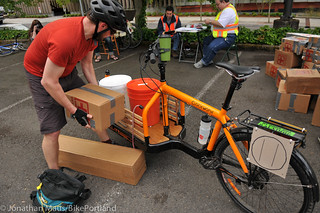
at a checkpoint located at the Red Cross on
N Vancouver Ave.
(Photos © J. Maus/BikePortland)
Sunday’s inaugural Disaster Relief Trials (DRT) was a big success on many levels.
The mock disaster scenario (a major earthquake) that the event was based on gave emergency responders and cargo bike enthusiasts a lot to think about. Disaster preparedness volunteers with the City’s Neighborhood Emergency Teams (NET) and the County’s Amateur Radio Emergency Service learned how to relay messages during a crisis, cargo bike builders learned how their designs performed under a variety of challenging, real-world conditions, and cargo bike operators learned how to push through the limits of pedal power.
At checkpoints scattered throughout a 30 miles swath of north and northeast Portland, the competitors (split between “Citizen” and “Open” classes) had to pedal through tricky obstacles and load and carry 100 pounds of cargo. The competitors tackled the course in all types of bike set-ups: There were standard bike and cargo trailer combos, longtails, two trikes, front loaders, and even a tall bike.
And a few shots of the bikes in action on the course:
The first checkpoint was the most challenging. It was set up to simulate how to get cargo bikes across damaged routes full of boulders, water, and other obstacles. As captured in photos by Will Vanlue, riders had to heave their large bikes over a 3-4 foot barrier, negotiate a pothole-strewn stretch of road, navigate a boulder field, then ride through a pond. (The three photos below are by Will Vanlue)
There were seven checkpoints in all and at each one volunteers relayed positions and messages back to base camp at Velo Cult Bike Shop in Hollywood. In the photos below, event co-organizer Travis Wittwer logs status updates of each rider and co-organizer Ethan Jewett makes announcements to the crowd…
As the riders finished, a big crowd showed up at the shop to welcome them back.
Beyond its success, the DRT has helped strengthen the community of cargo bike believers throughout Cascadia and it has once again expanded our perceptions of what bikes can do.
We’ve seen cargo bikes replace the mini-van for many Portland families, we’ve seen them serve as rolling storefronts for many local businesses, and now, thanks to the DRT, we’ve seen that these bikes can even act as a crucial transportation link following a major disaster.
The only question now is: Is there anything cargo bikes — and their dedicated and civic-minded owners — can’t do?
——
More on the 2012 DRT:
– Full BikePortland photo gallery of the event.
– Recap and thoughts from event organizers TRANSPORTland.
– Great photos from Prudent Cyclist.
– Coverage on OPB: Cargo Bikes Could Play Key Role in Crisis”



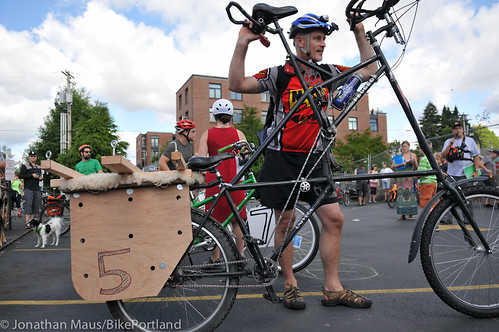
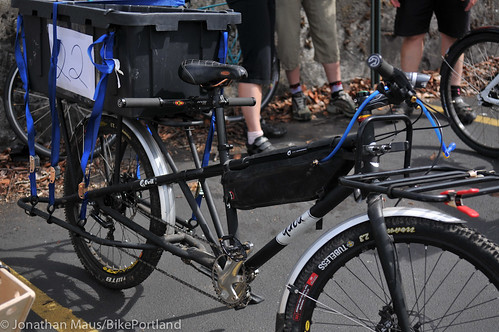
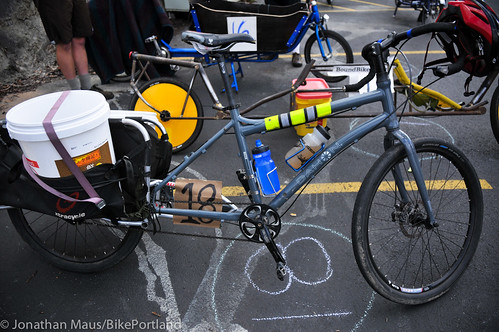
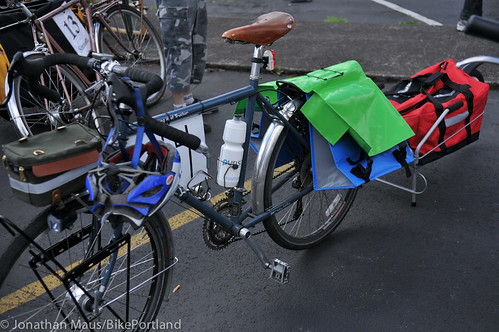
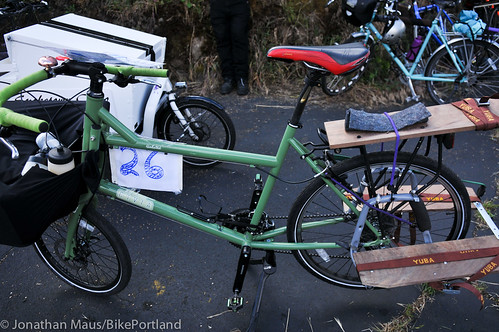
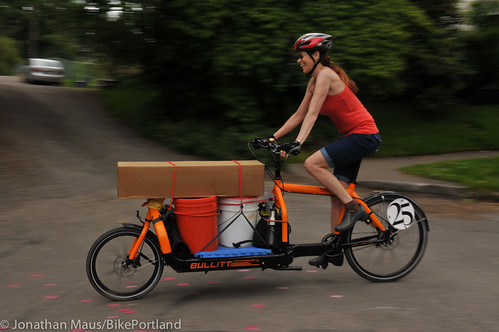


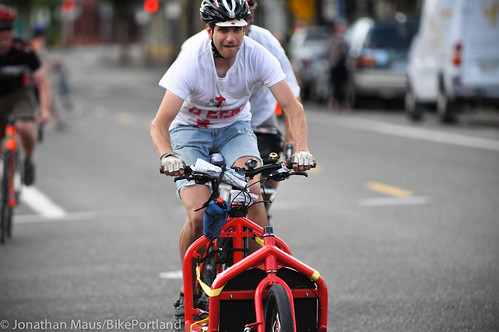
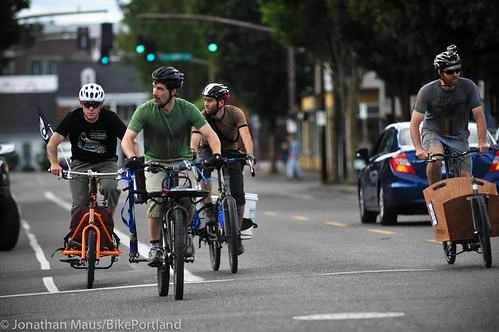
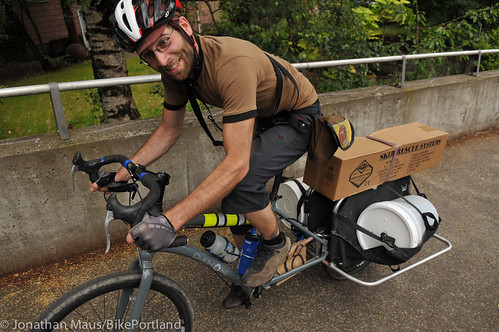
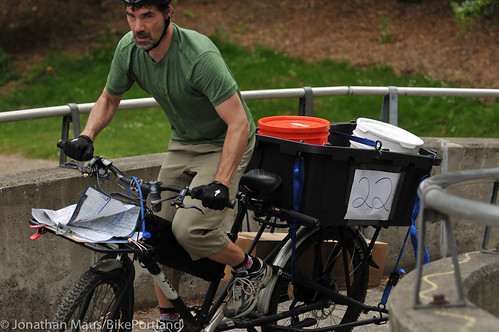
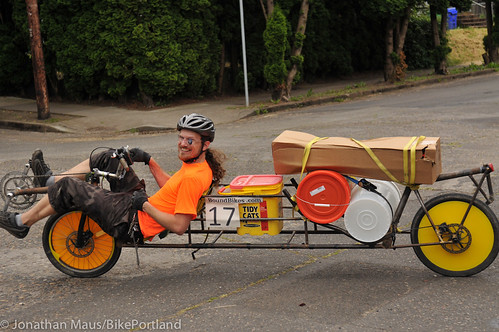
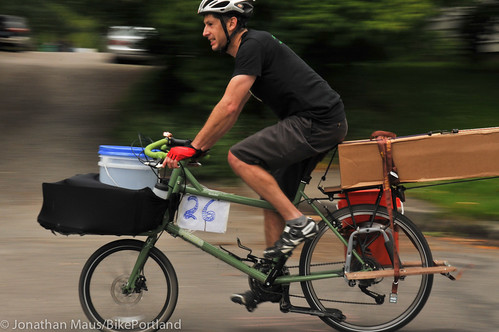


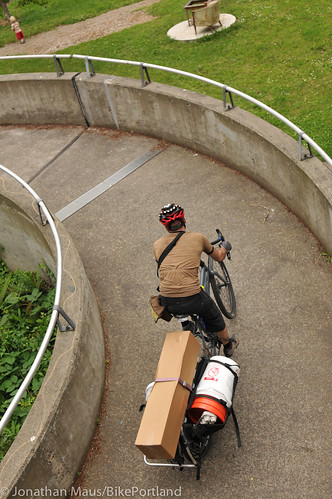

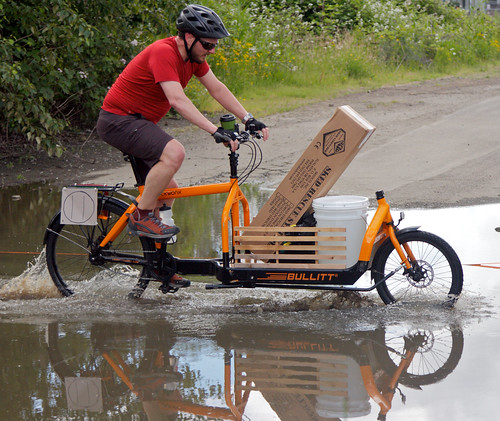
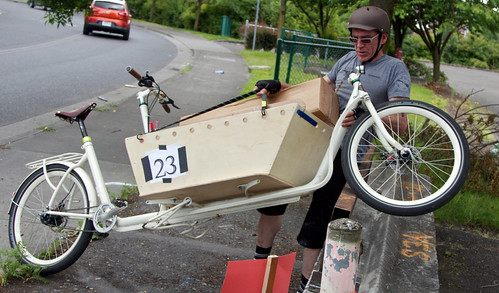
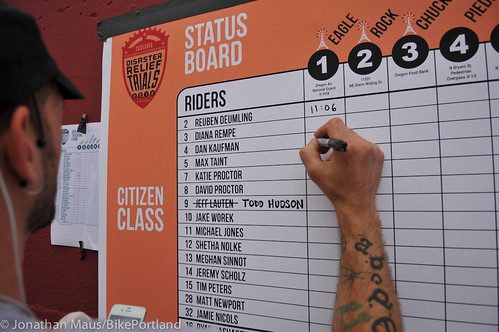

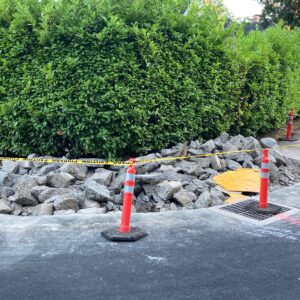
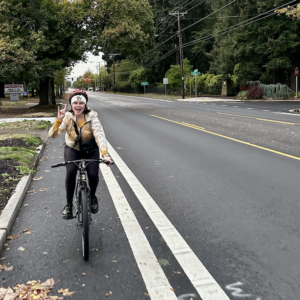

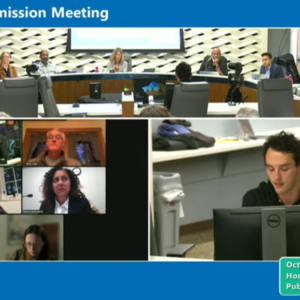
Thanks for reading.
BikePortland has served this community with independent community journalism since 2005. We rely on subscriptions from readers like you to survive. Your financial support is vital in keeping this valuable resource alive and well.
Please subscribe today to strengthen and expand our work.
Had a great time. Thanks to the dedicated people that put this together, including Velo Cult for hosting.
I only wish I could have been along with the racers. Next year!
next time throw in crowds of looters and a couple streets jam-packed with rude impatient motor vehicles and we’ll have an even more real-world scenario…
sure, being able to carry that much equipment is nice, but if the destruction is as severe as the scenario described then the obstacle course was way too easy… were there unimproved roads? I would expect a lot of natural debris as well as human-abandoned debris…
the pictures make it looks like a nice ride through the neighborhood with a couple spots of having to lift the bike and a couple puddles…
guess what I’m saying is that it needs a lot more chaos…
maybe just hold the event in outer-east Portland and the obstacles will present themselves… c(:
for a first-time event, they did a wonderful job. theres lots of room for improvement, but as someone whos ridden in and helped organize many races with similar structures, theres less to be “fixed” than i wouldve anticipated. as a racer, sure, i wouldve loved more weight, more distance, more obstacles, and more logistical complexity to the pickup/dropoff routing, but if theres no room for improvement, wheres the fun in doing it again?
Hi, I’ve been on a bicycle after an earthquake (Loma Prieta, 1989). It took out all the traffic lights. The cars are all just stopped, no big deal.
As to road conditions and cargo bikes — I already ride one, roads are already crappy here near Boston. My commute to work includes a low-gear scrabble up a short, steep slope (joining bike path to surface road), and a couple of curb hops. I’ve hopped curbs with my 100-lb daughter on the back, I’ve hauled her up a 7% grade (no electric assist, not in lowest gear, either).
And when it storms here and brings down trees across the bike path, I take a small pruning saw, and clear the way, tree-by-tree. Bikes can manage a much smaller passage than a car, so it is easier, and in a pinch sometimes you can dismount and wheel around.
Sometimes it snows badly here; again, bikes get through, cars get jammed up. This is not a prediction, this is what happens. A car in a drift needs a tow truck; a bike in a drift needs you to get off and haul it out. Ice? I can install snow tires with the same tools I use to fix a flat — not true of automobiles.
Sorry to say, The research shows that looting and chaos are the exception. I guess it’s more exciting to think we’ll suddenly have a lawless maelstrom on the streets, but in practice people help each other. Preparing for the worst is a valid approach, but don’t actually expect it.
Btw, people taking food from a supermarket (that they need) is not looting in my book. Taking a TV is, and I won’t be too interested in home entertainment in the aftermath of a disaster.
Looks like a young person’s event. I can’t imagine hoisting a large loaded bike over such obstacles – I have enough trouble getting a LWB recumbent up a short set of stairs.
Everyone would help in a crisis according to their ability.
Um, do these folks realize that in the event of a 9.0 megathrust earthquake, there will be no roads to bike on?
I’m sure that many of the road surfaces will survive the quake. The bridges will be toast, and there will be a lot of debris blocking the way. I’m sure some sinkholes here and there, cracks, crevasses, etc.
This brings up a good point: what about a water crossing for next year’s ride? Bridges are nearly all predicted to be impassable following the big one. What about a series of canoes stationed at the Columbia Slough to have to load bikes into and cross with?
On my list of things to do: Build a trailer with which I can haul my canoe by bike – like in case I have to paddle across the Willamette to pick up my GF when the bridges all collapse…
roads? where im going, i dont need roads.
a 9.0 megathrust will do many things. totally destroying *all* potentially navigable surfaces will not be one of them.
Steve, only the coast will see that kind of destruction you are contemplating. We are at considerable remove and while there will be cracked roads, and sections that are destroyed, all roads will not be impassible. Check out photos of cities in Japan that are similarly set back from their fault, or look at photos from the Good Friday quake in Alaska (and not just the dramatic downtown one. Christchurch was the same. Do some research.
After the Tsunami in Japan, bicycle stores were sold out as that was just about the only way to get around. It was all over the news at the time.
All you so quick to cast aspersions should come and participate or help next time. It was a very impressive event with lots of realism (in my opinion). As for age, there were lots of different ages represented. The last time I raced (on the same bike, btw) was 23 years ago. I definitely didn’t feel young.
I’m surprised everyone was able to hoist their cargo bikes over the barriers in question, fully loaded. I don’t think I could do that with my Madsen cargo bike. Without unloading it, anyway — did some people end up doing that?
Makes me wonder whether, if there were a significant amount of obstacles or rubble to deal with, it might be easier to manage on a regular bike with the BOB trailer. Far less cargo capacity, but fairly quick and easy to detach the trailer from the bike without unloading it, get over the obstacle separate from the bike, and reattach.
Yes to trailers and detaching for scaling real obstacles. 🙂
The bikes all got unloaded to get over the 1m barrier. At that point we had over 50lbs of gear in only two packages, so it was an easy decision to unload and reload. If there were more of that class of obstacle and/or less monolithic loads (two were in pickle buckets, two were in decently-sized boxes) then rigs with detachable holds would have been extremely useful.
60 pounds ;0)
I may have been the only one that got over the 1m barrier without unloading the portion of the load that we had at that point.
Matthew was able to hoist it without unloading – http://bit.ly/NcEHpe Matthew is 50+ and STRONG, like bull!
cargo bike = lever. the only reason i didnt lift my cargo bike over with the 60lb load in it is cause it wasnt lashed down. had i thought about it, i wouldve lashed things down purely to be able to send it over the barrier as one load…
Unload for barrier; hoist bike and cargo over, separately; and lashing back together was a hope for Checkpoint 2:ROCK. So hoisting bike with cargo over (as one unit of weight) was not a requirement, but an option chosen by some riders.
There’s a bit on All Things Considered tonight about this ride. Don’t have the link right now, maybe someone can post it later…
Didn’t find anything on All Things Considered — maybe it was OPB News? http://news.opb.org/article/cargo-bikes-could-play-key-role-crisis/
Ah yes, you are correct. Thanks for the link.
Great pictures! Looks challenging and fun. I hope to be there next year.
Thank you for the kind words and encouraging support of an event that had pratical applications to growth and organizing. I think Joel Metz captured it best in his interview with OPB where the premise was that you cannot prepare for the exact situation, but having experience can help you react with skill to whatever comes your way. The riders have been gracious with their praise and helpful with suggestions.
This event was not made to capture perfection. In many ways it was created to see what doesn’t work and how can we prepare.
Thanks to everyone for helping in this endeavor.
Ps, Checkpoint 2 (ROCK) was the obstacle checkpoint, not checkpoint 1 (EAGLE).
As a visitor to Portland and a survivor of the Christchurch, New Zealand quakes (as of today we’ve had 10, 481 since September 2010 & 6053 since the one that killed more than 180 people on 22 Feb 2011) i totally commend the people that organised & took part in thisevent. You are never going to simulate what it’s actually like but that’s not the point – you becoming aware of whay it might take to help. Whilst christchurch went into total grid-look with no electricity, water, sewerage, destroyed roads, buildings.fires, liquifaction you name it, people normally reliant on cars, public transit etc took hours to get home (to they knew not what). I managed to cycle home through the mayhem & it took hardly any longer than normal – proof that bikes really are versatile in extreme situations.
Glad you made it through the CH quake ok, my best friend and his wife live there and made it through pretty ok (liquification of their yard and loss of their chimney, but nothing shovels and trowels couldn’t help). This was a great event and I look forward to participating again next year. I’ll have a bit more time on the CETMA at that time, so maybe Joel’s desire of heavier and longer won’t be so scary. 🙂
I saw the DRT start out and come back in…. a ton of work for the organizers and participants; I was impressed! Have already told the organizers that I want to volunteer for next year!